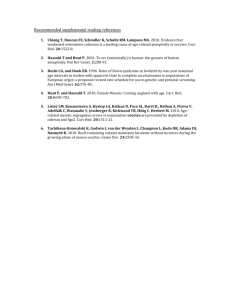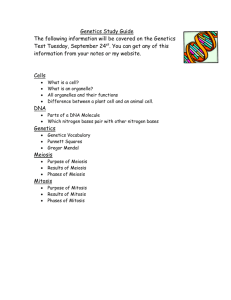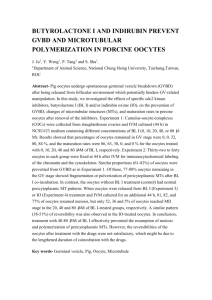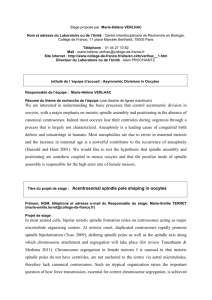Causes and consequences of maternal age
advertisement
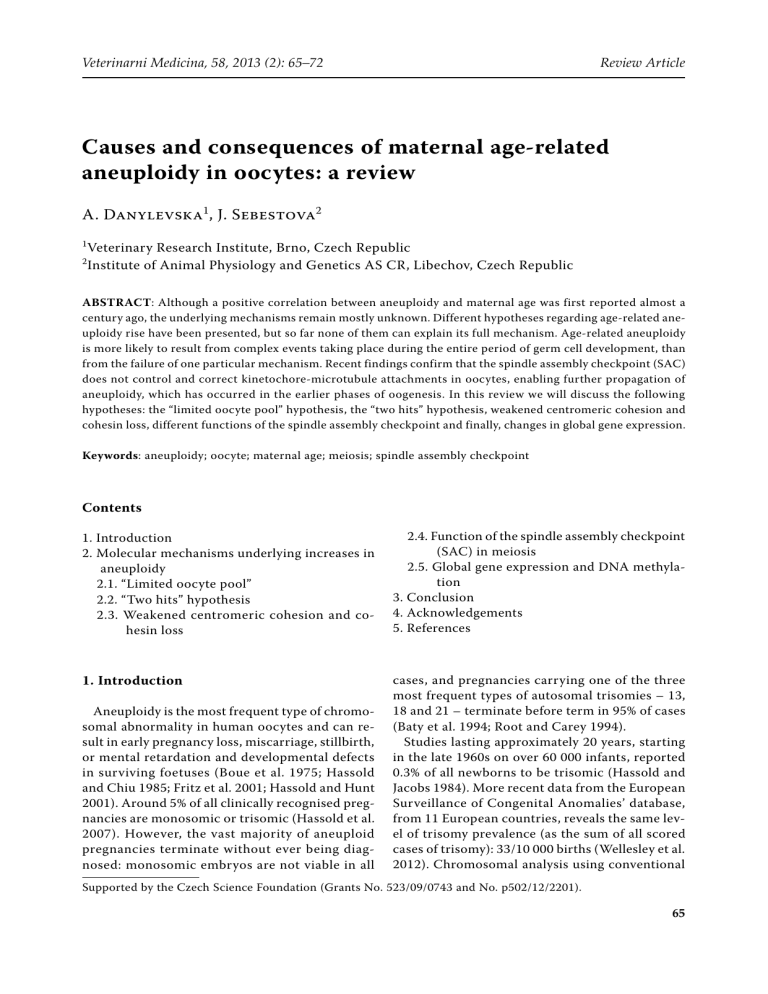
Veterinarni Medicina, 58, 2013 (2): 65–72 Review Article Causes and consequences of maternal age-related aneuploidy in oocytes: a review A. Danylevska1, J. Sebestova2 1 2 Veterinary Research Institute, Brno, Czech Republic Institute of Animal Physiology and Genetics AS CR, Libechov, Czech Republic ABSTRACT: Although a positive correlation between aneuploidy and maternal age was first reported almost a century ago, the underlying mechanisms remain mostly unknown. Different hypotheses regarding age-related aneuploidy rise have been presented, but so far none of them can explain its full mechanism. Age-related aneuploidy is more likely to result from complex events taking place during the entire period of germ cell development, than from the failure of one particular mechanism. Recent findings confirm that the spindle assembly checkpoint (SAC) does not control and correct kinetochore-microtubule attachments in oocytes, enabling further propagation of aneuploidy, which has occurred in the earlier phases of oogenesis. In this review we will discuss the following hypotheses: the “limited oocyte pool” hypothesis, the “two hits” hypothesis, weakened centromeric cohesion and cohesin loss, different functions of the spindle assembly checkpoint and finally, changes in global gene expression. Keywords: aneuploidy; oocyte; maternal age; meiosis; spindle assembly checkpoint Contents 1. Introduction 2. Molecular mechanisms underlying increases in aneuploidy 2.1. “Limited oocyte pool” 2.2. “Two hits” hypothesis 2.3. Weakened centromeric cohesion and cohesin loss 2.4. Function of the spindle assembly checkpoint (SAC) in meiosis 2.5. Global gene expression and DNA methylation 3. Conclusion 4. Acknowledgements 5. References 1. Introduction cases, and pregnancies carrying one of the three most frequent types of autosomal trisomies – 13, 18 and 21 – terminate before term in 95% of cases (Baty et al. 1994; Root and Carey 1994). Studies lasting approximately 20 years, starting in the late 1960s on over 60 000 infants, reported 0.3% of all newborns to be trisomic (Hassold and Jacobs 1984). More recent data from the European Surveillance of Congenital Anomalies’ database, from 11 European countries, reveals the same level of trisomy prevalence (as the sum of all scored cases of trisomy): 33/10 000 births (Wellesley et al. 2012). Chromosomal analysis using conventional Aneuploidy is the most frequent type of chromosomal abnormality in human oocytes and can result in early pregnancy loss, miscarriage, stillbirth, or mental retardation and developmental defects in surviving foetuses (Boue et al. 1975; Hassold and Chiu 1985; Fritz et al. 2001; Hassold and Hunt 2001). Around 5% of all clinically recognised pregnancies are monosomic or trisomic (Hassold et al. 2007). However, the vast majority of aneuploid pregnancies terminate without ever being diagnosed: monosomic embryos are not viable in all Supported by the Czech Science Foundation (Grants No. 523/09/0743 and No. p502/12/2201). 65 Review Article cytogenetic methods allowed the estimation that over 20% of human oocytes carry numerical aberrations (Eichenlaub-Ritter 1998). Studies performed on 20 000 oocytes analyzed by FISH (analyzing chromosomes 13, 16, 18, 21 and 22) reveal an aneuploidy rate of 46.8% (Kuliev et al. 2011). The first evidence for the positive correlation between the occurrence of Down syndrome and advanced maternal age was provided in 1933 (Penrose 1933). From that time the relationship between aneuploidy rates and increasing maternal age has been clearly proven (Hassold and Hunt 2001, 2009; Hunt and Hassold 2008, 2010; Otter et al. 2010). While only 2–3% of pregnancies in women in their twenties involve trisomic foetuses, two decades later the same finding affects 35% of clinically recognised pregnancies (Hassold and Hunt 2001, 2009; Hunt and Hassold 2008, 2010). Analysis of chromosomes 13, 15, 16, 18, 21, 22 in the first polar body (PB) of eggs earmarked for IVF, showed an increase in aneuploidy occurrence from 20% in women of 35 years old, up to 60% in 43 years of age and older (Gianaroli et al. 2010; Kuliev et al. 2011). Humans are not the only species affected by aneuploidy in oocytes. Studies on mice, pigs and cattle revealed the occurrence of aneuploidy in their oocytes (Golbus 1981; Zackowski and Martin-Deleon 1988; Lechniak and Switonski 1998; Zuccotti et al. 1998; Duncan et al. 2009; Nicodemo et al. 2010; Hornak et al. 2011; Sebestova et al. 2012). However, while a positive correlation between maternal age and aneuploidy was observed in naturally aged mice (Duncan et al. 2009; Sebestova et al. 2012), no such correlation was observed in pigs (Hornak et al. 2011). 2. Molecular mechanisms underlying increases in aneuploidy There is currently a clear trend for humans to have children later in life. Therefore, there is much interest in understanding the mechanisms, which may be involved in the age-related rise in aneuploidy. The following hypotheses have appeared during the past decades: (1) “limited oocyte pool” hypothesis, (2) ”two-hits” hypothesis, (3) weakened centromeric cohesion and cohesin loss, (4) different function of the spindle assembly checkpoint, and (5) changes in global gene expression. In this review we will describe these hypotheses and critically evaluate them in the light of the latest research findings. 66 Veterinarni Medicina, 58, 2013 (2): 65–72 2.1. “Limited oocyte pool” Even though it has been reported that germline stem cells are present in the ovaries of adult individuals (Johnson et al. 2004; White et al. 2012), it is generally accepted that ovarian follicles are formed during the foetal development of females. From this moment their number decreases until it reaches a critical level and menopause occurs. Around the age of 25 approximately 100 000 follicles are present in the ovaries; by the age of 45 this number has dropped to several thousands (Gougeon et al. 1994; Gougeon 1998). After reaching puberty, a subpopulation of oocytes is recruited monthly to undergo growth and become antral follicles. In humans, usually only one follicle, the most sensitive to FSH stimulation, will complete maturation and ovulate. There are, on average, 21 selectable follicles on both ovaries of women between the ages of 19–30; however, this number declines to 2–3 by the age of 40 (Gougeon 1998). The “limited oocyte pool” hypothesis suggests that the lower number of antral follicles in older women’s ovaries causes the recruitment of suboptimal – premature or postmature – oocytes for ovulation (Warburton 1989). In addition, according to the oocyte selection model, cells of a higher quality are preferably selected for ovulation (Zheng and Byers 1992; Eichenlaub-Ritter 1998; Broekmans et al. 2009). If the hypothesis is correct, a higher level of aneuploidy in women with a reduced oocyte pool should be expected regardless of their age. Vice versa, a history of aneuploid pregnancies should predict a reduced oocyte pool size. This, however, has not been confirmed by clinical data (Warburton 2005). Because the reduction of the oocyte pool due to variable aetiology (premature ovarian failure (Nippita and Baber 2007), smoking (Yang et al. 1999; Pacchierotti et al. 2007), ovariectomy) affects women of different ages, this hypothesis clearly contradicts the correlation between the increase of aneuploidy with age. 2.2. “Two hits” hypothesis During early embryonic development in prophase I chromosomes pair up and synaptonemal complexes form (Zickler and Kleckner 1998; Walker and Hawley 2000; Page and Hawley 2003, 2004). Later, this leads to the formation of crossing overs between non-sister chromatids of homologous chromosomes (Kleckner 2006). Resulting in the Veterinarni Medicina, 58, 2013 (2): 65–72 formation of a structure called ‘bivalent’ by two homologous chromosomes, one from the mother and one from the father. The “Two hits” hypothesis suggests that the number and distribution of chiasmata established in prophase I may affect chromosome segregation in meiosis I, and subsequently in meiosis II (Lamb et al. 1996; Ghosh et al. 2009, 2011. While a low number of chiasmata formed close to telomeres could lead to premature bivalent segregation, proximal or multiple chiasmata can cause the formation of disomic gamete by non-disjunction in MI (Jones 2008). According to this hypothesis, chiasmata formation is the first step in aneuploid egg genesis. During the second step, a ‘susceptible’ configuration of chiasmata, as described in step 1, leads to the disintegration of meiosis and, as a result, a rise in aneuploidy. A correlation between a reduced number of recombination events and increased aneuploidy has been demonstrated in mice, yeast and Drosophila (Malone and Esposito 1981; Hawley 2003; Jeffreys et al. 2003). However, studies on 400 cases of trisomy 21 of maternal meiosis I origin reveal a negative correlation between the number of ‘susceptible’ recombination events and maternal age: only 10% of telomeric or pericentromeric exchanges were found in a group of women over 34 years old, while in woemn younger than 29 the percentage of susceptible patterns reaches 34% (Lamb et al. 2005). 2.3. Weakened centromeric cohesion and cohesin loss In meiosis I, homologues remain paired until anaphase I, due to chiasmata and a protein complex called ‘cohesin’, distal from chiasmata (Nasmyth and Haering 2005, 2009). Sister chromatids are held together by cohesin on their centromeres and pericentromeric regions (Page and Hawley 2003; Hauf and Watanabe 2004; Nasmyth and Haering 2005). The cohesion between homologous chromosomes has to be abolished (by separase cleavage) at the onset of anaphase I for proper segregation of the univalents (Buonomo et al. 2000; Kudo et al. 2006, 2009). In contrast, the centromeric cohesion between sister chromatids must stay intact until anaphase II (Petronczki et al. 2003). This chromosome behaviour, particular for meiosis, would not be possible without the preservation Review Article of a sufficient amount of cohesin on the sister chromatid centromeres and on the chromosome arms, from the moment of the establishment of the cohesion during prenatal development until the resumption of meiosis in sexually mature females. During this period, which could last decades in humans, cohesin is maintained on chromosomes without turnover (Tachibana-Konwalski et al. 2010). Cohesin present on sister chromatid centromeres has to be protected against separase cleavage in anaphase I, to prevent precocious segregation of sister chromatids. The shugoshins (Sgo1 and Sgo2) are the proteins which, among their other functions, protect cohesin against proteolysis (Kitajima et al. 2006; Xu et al. 2009), by associating with protein phosphatase 2A (PP2A) and recruiting it to sister chromatid centromeres in oocytes (Riedel et al. 2006; Rivera and Losada 2006). Separase is unable to cleave the meiotic specific subunit of cohesin REC8 dephosphorylated by PP2A, so the cohesion between sister chromatids remains intact in meiosis I. Two mechanisms, a reduced level of cohesin and insufficient centromere protection, could contribute to the rise of aneuploidy with age (Hodges et al. 2005; Vogt et al. 2008). Experiments performed on naturally aged mice have demonstrated a decrease in chromosome associated REC8 protein, both in prophase-arrested and MI oocytes (Chiang et al. 2010; Lister et al. 2010). Cohesin loss would, however, not indicate cohesion weakness by itself. It has been shown that the intra- and inter-kinetochore distance is enhanced in old oocytes, in comparison with young oocytes. In addition, the depletion of Sgo2 in oocytes from old mice was observed (Lister et al. 2010). Disruption of the mechanisms maintaining chromosomal cohesion leads to premature segregation of univalent in oocytes from old mice (Sebestova et al. 2012). However, sister chromatids were found only after induced premature separase activation, by inhibition of its regulatory mechanisms (Chiang et al. 2011). Oocytes from old mice appeared to be more sensitive to premature separase activation than oocytes from young mice, indicating weakened cohesion. Cohesion loss, whether due to cohesin depletion or insufficient protecting mechanisms in oocytes from older females, could lead to precocious chromosome segregation. Pre-division, however, causes approximately 60% of aneuploidies (Dailey et al. 1996; Rosenbusch 2004, 2006); the remaining 40% are caused by non-disjunction and cannot, therefore, be explained by the cohesion loss hypothesis. 67 Review Article Veterinarni Medicina, 58, 2013 (2): 65–72 2.4. Function of the spindle assembly checkpoint (SAC) in meiosis 2.5. Global gene expression and DNA methylation The spindle assembly checkpoint (SAC) is the key regulatory mechanism in dividing cells, which controls anaphase entry by monitoring chromosome attachment to spindle microtubules (Musacchio and Hardwick 2002; Homer 2006; Musacchio and Salmon 2007; Musacchio 2011; Akiyoshi and Biggins 2012; DeLuca and Musacchio 2012). In mitosis, one unattached kinetochore is sufficient for producing the ‘wait anaphase signal’ and arresting the cell cycle in metaphase (Nicklas and Arana 1992; Malmanche et al. 2006). Subsequently, a mechanism involving Aurora B kinase, and other components, corrects the improperly attached chromosomes (Lampson et al. 2004; Shuda et al. 2009; Lampson and Cheeseman 2011). The presence of the SAC in oocytes has been proven by their arrest in metaphase I upon exposure to the microtubule-depolymerising drug nocodazole, resulting from kinetochore-microtubule attachment disruption (Duncan et al. 2009; Lister et al. 2010; Sebestova et al. 2012). It has also been demonstrated that depletion of core SAC components, such as Mad2, Bub1 and BubR1, causes premature chromosome segregation and anaphase I onset (Homer et al. 2005; McGuinness et al. 2009; Wei et al. 2010). However, the presence of the SAC in both mitosis and meiosis does not necessarily indicate a similar function. Research has shown that a critical mass of approximately 80% of the chromosomes correctly aligned on the metaphase plate is sufficient to satisfy the SAC and allow a cell to proceed to anaphase in meiosis I (Nagaoka et al. 2011). Measuring the intensity of the ‘wait anaphase signal’ of chromosomes on the equatorial plane and spindle poles demonstrates that this signalling and its dynamics are not dependent on chromosome position (Gui and Homer 2012). Additional research has confirmed these findings, demonstrating that SAC silencing at the onset of anaphase-promoting complex/cyclosome (APC/C) activity in meiosis I takes place despite the fact that chromosomal congression on the metaphase plate is not yet achieved (Lane et al. 2012). The latest publication on this topic by Sebestova et al. shows that multiple unaligned chromosomes are not competent either to arrest or delay metaphase-to-anaphase transition in meiosis I (Sebestova et al. 2012). This clearly indicates that in meiosis the SAC functions only as a ‘timer’ for APC/C activation. An alternative hypothesis pointing to the influence of maternal age on global gene expression has been offered as an explanation for the increase in aneuploidy with age (Jones 2008). Global gene expression changes during oocyte development (Schultz 2005). While the transcript in oocytes from old and young mice are similar, the transcriptome in eggs differs significantly (Hamatani et al. 2004; Pan et al. 2008). However, further research into the effect of decreased transcription on gene function, for example of DNA methyltransferases, showed no differences in the methylation of differentially methylated regions in imprinted genes (Lopes et al. 2009), calling in to question the significance of decreased global gene expression for the developing embryo. 68 3. Conclusion Aneuploidy is the leading cause of reduced fertility in females and developmental abnormalities in foetuses. None of the different hypotheses which have been advanced to explain the age-related increase in rates of aneuploidy could so far explain the mechanism completely. The incidence of aneuploidy in oocytes from older females appears to be rather the result of several events than an insufficiency in one mechanism. The number and distribution of chiasmata formed during early prophase I as well as weakened centromeric cohesion, establish a strong predisposition for aneuploidy. This, in combination with the absence of a mechanism, which detects and corrects erroneously attached chromosomes in oocytes, results in an increased possibility of aneuploid egg formation and – more importantly – the propagation of aneuploidy in the newly developing embryo. New findings about SAC function in oocytes have imparted an impulse toward the re-valuation of the roles played by different mechanisms in age-related aneuploidy, demonstrating that further investigation is required. 4. Acknowledgement We are grateful to Martin Anger, Veterinary Research Institute, Brno, Czech Republic for critically reading the manuscript. Veterinarni Medicina, 58, 2013 (2): 65–72 5. REFERENCES Akiyoshi B, Biggins S (2012): Reconstituting the kinetochore-microtubule interface: what, why, and how. Chromosoma 121, 235–250. Baty BJ, Blackburn BL, Carey JC (1994): Natural history of trisomy 18 and trisomy 13: I. Growth, physical assessment, medical histories, survival, and recurrence risk. American Journal of Medical Genetics 49, 175– 188. Boue J, Bou A, Lazar P (1975): Retrospective and prospective epidemiological studies of 1500 karyotyped spontaneous human abortions. Teratology 12, 11–26. Broekmans FJ, Soules MR, Fauser BC (2009): Ovarian aging: mechanisms and clinical consequences. Endocrine Reviews 30, 465–493. Buonomo SB, Clyne RK, Fuchs J, Loidl J, Uhlmann F, Nasmyth K (2000): Disjunction of homologous chromosomes in meiosis I depends on proteolytic cleavage of the meiotic cohesin Rec8 by separin. Cell 103, 387– 398. Chiang T, Duncan FE, Schindler K, Schultz RM, Lampson MA (2010): Evidence that weakened centromere cohesion is a leading cause of age-related aneuploidy in oocytes. Current Biology 20, 1522–1528. Chiang T, Schultz R, Lampson M (2011): Age-dependent susceptibility of chromosome cohesion to premature separase activation in mouse oocytes. Biology of Reproduction 85, 1279–1283. Dailey T, Dale B, Cohen J, Munne S (1996): Association between nondisjunction and maternal age in meiosis-II human oocytes. American Journal of Human Genetics 59, 176–184. DeLuca JG, Musacchio A (2012): Structural organization of the kinetochore-microtubule interface. Current Opinion in Cell Biology 24, 48–56. Duncan FE, Chiang T, Schultz RM, Lampson MA (2009): Evidence that a defective spindle assembly checkpoint is not the primary cause of maternal age-associated aneuploidy in mouse eggs. Biology of Reproduction 81, 768–776. Eichenlaub-Ritter U (1998): Genetics of oocyte ageing. Maturitas 30, 143–169. Fritz B, Hallermann C, Olert J, Fuchs B, Bruns M, Aslan M, Schmidt S, Coerdt W, Muntefering H, Rehder H (2001): Cytogenetic analyses of culture failures by comparative genomic hybridisation (CGH)-Re-evaluation of chromosome aberration rates in early spontaneous abortions. European Journal of Human Genetics 9, 539–547. Ghosh S, Feingold E, Dey SK (2009): Etiology of Down syndrome: Evidence for consistent association among Review Article altered meiotic recombination, nondisjunction, and maternal age across populations. American Journal of Medical Genetics 149A, 1415–1420. Ghosh S, Hong CS, Feingold E, Ghosh P, Ghosh P, Bhaumik P, Dey SK (2011): Epidemiology of Down syndrome: new insight into the multidimensional interactions among genetic and environmental risk factors in the oocyte. American Journal of Epidemiology 174, 1009–1016. Gianaroli L, Magli MC, Cavallini G, Crippa A, Capoti A, Resta S, Robles F, Ferraretti AP (2010): Predicting aneuploidy in human oocytes: key factors which affect the meiotic process. Human Reproduction 25, 2374–2386. Golbus MS (1981): The influence of strain, maternal age, and method of maturation on mouse oocyte aneuploidy. Cytogenetics and Cell Genetics 31, 84–90. Gougeon A (1998): Ovarian follicular growth in humans: ovarian ageing and population of growing follicles. Maturitas 30, 137–142. Gougeon A, Ecochard R, Thalabard JC (1994): Age-related changes of the population of human ovarian follicles: increase in the disappearance rate of non-growing and early-growing follicles in aging women. Biology of Reproduction 50, 653–663. Gui L, Homer H (2012): Spindle assembly checkpoint signalling is uncoupled from chromosomal position in mouse oocytes. Development 139, 1941–1946. Hamatani T, Falco G, Carter MG, Akutsu H, Stagg CA, Sharov AA, Dudekula DB, VanBuren V, Ko MS (2004): Age-associated alteration of gene expression patterns in mouse oocytes. Human Molecular Genetics 13, 2263–2278. Hassold T, Chiu D (1985): Maternal age-specific rates of numerical chromosome abnormalities with special reference to trisomy. Human Genetics 70, 11–17. Hassold T, Hunt P (2001): To err (meiotically) is human: the genesis of human aneuploidy. Nature Reviews Genetics 2, 280–291. Hassold T, Hunt P (2009): Maternal age and chromosomally abnormal pregnancies: what we know and what we wish we knew. Current Opinion in Pediatrics 21, 703–708. Hassold T, Jacobs PA (1984): Trisomy in man. Annual Review of Genetics 18, 69–97. Hassold T, Hall H, Hunt P (2007): The origin of human aneuploidy: where we have been, where we are going. Human Molecular Genetics 16, 203–208. Hauf S, Watanabe Y (2004): Kinetochore orientation in mitosis and meiosis. Cell 119, 317–327. Hawley RS (2003): Human meiosis: model organisms address the maternal age effect. Current Biology 13, 305–307. 69 Review Article Hodges CA, Ravenkova E, Jessberger R, Hassold TJ, Hunt PA (2005): SMC1b-deficient female mice provide evidence that cohesins are a missing link in age-related nondisjunction. Nature Genetics 37, 1351–1355. Homer HA (2006): Mad2 and spindle assembly checkpoint function during meiosis I in mammalian oocytes. Histology and Histopathology 21, 873–886. Homer HA, McDougall A, Levasseur M, Murdoch AP, Herbert M (2005): Mad2 is required for inhibiting securin and cyclin B degradation following spindle depolymerisation in meiosis I mouse oocytes. Reproduction 130, 829–843. Hornak M, Jeseta M, Musilova P, Pavlok A, Kubelka M, Motlik J, Rubes J, Anger M (2011): Frequency of aneuploidy related to age in porcine oocytes. PLoS One 6, e18892. Hunt PA, Hassold TJ (2008): Human female meiosis: what makes a good egg go bad? Trends in Genetics 24, 86–93. Hunt P, Hassold T (2010): Female meiosis: coming unglued with age. Current Biology 20, 699–702. Jeffreys CA, Burrage PS, Bickel SE (2003): A model system for increased meiotic nondisjunction in older oocytes. Current Biology 13, 498–503. Johnson J, Canning J, Kaneko T, Pru JK, Tilly JL (2004): Germline stem cells and follicular renewal in the postnatal mammalian ovary. Nature 428, 145–150. Jones KT (2008): Meiosis in oocytes: predisposition to aneuploidy and its increased incidence with age. Human Reproduction Update 14, 143–158. Kitajima TS, Sakuno T, Ishiguro K, Iemura S, Natsume T, Kawashima SA, Watanabe Y (2006): Shugoshin collaborates with protein phosphatase 2A to protect cohesin. Nature 441, 46–52. Kleckner N (2006): Chiasma formation: chromatin/axis interplay and the role(s) of the synaptonemal complex. Chromosoma 115, 175–194. Kudo NR, Wassmann K, Anger M, Schuh M, Wirth KG, Xu H, Helmhart W, Kudo H, McKay M, Maro B, Ellenberg J, de Boer P, Nasmyth K (2006): Resolution of chiasmata in oocytes requires separase-mediated proteolysis. Cell 126, 135–146. Kudo NR, Anger M, Peters AH, Stemmann O, Theussl HC, Helmhart W, Kudo H, Heyting C, Nasmyth K (2009): Role of cleavage by separase of the Rec8 kleisin subunit of cohesin during mammalian meiosis I. Journal of Cell Science 122, 2686–2698. Kuliev A, Zlatopolsky Z, Kirillova I, Spivakova J, Cieslak Janzen J (2011): Meiosis errors in over 20,000 oocytes studied in the practice of preimplantation aneuploidy testing. Reproductive BioMedicine Online 22, 2–8. Lamb NE, Freeman SB, Savage-Austin A, Pettay D, Taft L, Hersey J, Gu Y, Shen J, Saker D, May KM, Avramo- 70 Veterinarni Medicina, 58, 2013 (2): 65–72 poulos D, Petersen MB, Hallberg A, Mikkelsen M, Hassold TJ, Sherman SL (1996): Susceptible chiasmate configurations of chromosome 21 predispose to nondisjunction in both maternal meiosis I and meiosis II. Nature Genetics 14, 400–405. Lamb NE, Yu K, Shaffer J, Feingold E, Sherman SL (2005): Association between maternal age and meiotic recombination for trisomy 21. American Journal of Human Genetics 76, 91–99. Lampson MA, Cheeseman IM (2011): Sensing centromere tension: Aurora B and the regulation of kinetochore function. Trends in Cell Biology 21, 133–140. Lampson MA, Renduchitala K, Khodjakov A, Kapoor TM (2004): Correcting improper chromosome-spindle attachments during cell division. Nature Cell Biology 6, 232–237. Lane SIR, Yun Y, Jones KT (2012): Timing of anaphasepromoting complex activation in mouse oocytes is predicted by microtubule-kinetochore attachment but not by bivalent alignment or tension. Development 139, 1947–1955. Lechniak D, Switonski M(1998): Aneuploidy in bovine oocytes matured in vitro. Chromosome Research 6, 504–506. Lister LM, Kouznetsova A, Hyslop LA, Kalleas D, Pace SL, Barel JC, Nathan A, Floros V, Adelfalk C, Watanabe Y, Jessberger R, Kirkwood TB, Hoog C, Herbert M (2010): Age-related meiotic segregation errors in mammalian oocytes are preceded by depletion of cohesin and Sgo2. Current Biology 20, 1511–1521. Lopes FL, Fortier AL, Darricarrere N, Chan D, Arnold DR, Trasler JM (2009): Reproductive and epigenetic outcomes associated with aging mouse oocytes. Human Molecular Genetics 18, 2032–2044. Malmanche N, Maia A, Sunkel CE (2006): The spindle assembly checkpoint: preventing chromosome missegregation during mitosis and meiosis. FEBS Letters 580, 2888–2895. Malone RE, Esposito RE (1981): Recombinationless meiosis in Saccharomyces cerevisiae. Molecular and Cellular Biology 1, 891–901. McGuinness BE, Anger M, Kouznetsova A, Gil-Bernabe AM, Helmhart W, Kudo NR, Wuensche A, Taylor S, Hoog C, Novak B, Nasmyth K (2009): Regulation of APC/C activity in oocytes by a Bub1-dependent spindle assembly checkpoint. Current Biology 19, 369–380. Musacchio A. (2011): Spindle assembly checkpoint: the third decade. Philosophical Transactions of the Royal Society B: Biological Sciences 366, 3595–3604. Musacchio A, Hardwick KG (2002): The spindle checkpoint: structural insights into dynamic signalling. Nature Reviews Molecular Cell Biology 3, 731–741. Veterinarni Medicina, 58, 2013 (2): 65–72 Musacchio A, Salmon ED (2007): The spindle-assembly checkpoint in space and time. Nature Reviews Molecular Cell Biology 8, 379–393. Nagaoka SI, Hodges CA, Albertini DF, Hunt PA (2011): Oocyte-specific differences in cell-cycle control create an innate susceptibility to meiotic errors. Current Biology 21, 651–657. Nasmyth K, Haering CH (2005): The structure and function of SMC and kleisin complexes. Annual Review of Biochemistry 74, 595–648. Nasmyth K, Haering CH (2009): Cohesin: its roles and mechanisms. Annual Review of Genetics 43, 525–558. Nicklas RB, Arana P (1992): Evolution and the meaning of metaphase. Journal of Cell Science 102, 681–690. Nicodemo D, Pauciullo A, Cosenza G, Peretti V, Perucatti A, Di Meo GP, Ramunno L, Iannuzzi L, Rubes J, Di Berardino D (2010): Frequency of aneuploidy in in vitro-matured MII oocytes and corresponding first polar bodies in two dairy cattle (Bos taurus) breeds as determined by dual-color fluorescent in situ hybridization. Theriogenology 73, 523–529. Nippita TA, Baber RJ (2007): Premature ovarian failure: a review. Climacteric 10, 11–22. Otter M, Schrander-Stumpel CT, Curfs LM (2010): Triple X syndrome: a review of the literature. European Journal of Human Genetics 18, 265–271. Pacchierotti F, Adler ID, Eichenlaub-Ritter U, Mailhes JB (2007): Gender effects on the incidence of aneuploidy in mammalian germ cells. Environmental Research 104, 46–69. Page SL, Hawley RS (2003): Chromosome choreography: the meiotic ballet. Science 301, 785–789. Page SL, Hawley RS (2004): The genetics and molecular biology of the synaptonemal complex. Annual Review of Cell and Developmental Biology 20, 525–558. Pan H, Ma P, Zhu W, Schultz RM (2008): Age-associated increase in aneuploidy and changes in gene expression in mouse eggs. Developmental Biology 316, 397–407. Penrose LS (1933): The relative effects of paternal and maternal age in mongolism. 1933. Journal of Genetics 88, 9–14. Petronczki M, Siomos MF, Nasmyth K (2003): Un menage a quatre: the molecular biology of chromosome segregation in meiosis. Cell 112, 423–440. Riedel CG, Katis VL, Katou Y, Mori S, Itoh T, Helmhart W, Galova M, Petronczki M, Gregan J, Cetin B, Mudrak I, Ogris E, Mechtler K, Pelletier L, Buchholz F, Shirahige K, Nasmyth K (2006): Protein phosphatase 2A protects centromeric sister chromatid cohesion during meiosis I. Nature 441, 53–61. Rivera T, Losada A (2006): Shugoshin and PP2A, shared duties at the centromere. BioEssays 28, 775–779. Review Article Root S, Carey JC (1994): Survival in trisomy 18. American Journal of Medical Genetics 49, 170–174. Rosenbusch B (2004): The incidence of aneuploidy in human oocytes assessed by conventional cytogenetic analysis. Hereditas 141, 97–105. Rosenbusch B (2006): The contradictory information on the distribution of non-disjunction and pre-division in female gametes. Human Reproduction 21, 2739–2742. Schultz RM (2005): From egg to embryo: a peripatetic journey. Reproduction 130, 825–828. Sebestova J, Danylevska A, Novakova L, Kubelka M, Anger M (2012): Lack of response to unaligned chromosomes in mammalian female gametes. Cell Cycle 11, 3011–3018. Shuda K, Schindler K, Ma J, Schultz RM, Donovan PJ (2009): Aurora kinase B modulates chromosome alignment in mouse oocytes. Molecular Reproduction and Development 76, 1094–1105. Tachibana-Konwalski K, Godwin J, Van der Weyden L, Champion L, Kudo NR, Adams DJ, Nasmyth K (2010): Rec8-containing cohesin maintains bivalents without turnover during the growing phase of mouse oocytes. Genes and Development 24, 2505–2516. Vogt E, Kirsch-Volders M, Parry J, Eichenlaub-Ritter U (2008): Spindle formation, chromosome segregation and the spindle checkpoint in mammalian oocytes and susceptibility to meiotic error. Mutation Research/Genetic Toxicology and Environmental Mutagenesis 651, 14–29. Walker MY, Hawley RS (2000): Hanging on to your homolog: the roles of pairing, synapsis and recombination in the maintenance of homolog adhesion. Chromosoma 109, 3–9. Warburton D (1989): The effect of maternal age on the frequency of trisomy: change in meiosis or in utero selection? Progress in Clinical and Biological Research 311, 165–181. Warburton D (2005): Biological aging and the etiology of aneuploidy. Cytogenetic and Genome Research 111, 266–272. Wei L, Liang XW, Zhang QH, Li M, Yuan J, Li S, Sun SC, Ouyang YC, Schatten H, Sun QY (2010): BubR1 is a spindle assembly checkpoint protein regulating meiotic cell cycle progression of mouse oocyte. Cell Cycle 9, 1112–1121. Wellesley D, Dolk H, Boyd PA, Greenlees R, Haeusler M, Nelen V, Garne E, Khoshnood B, Doray B, Rissmann A, Mullaney C, Calzolari E, Bakker M, Salvador J, Addor MC, Draper E, Rankin J, Tucker D (2012): Rare chromosome abnormalities, prevalence and prenatal diagnosis rates from population-based congenital anomaly registers in Europe. European Journal of Human Genetics 20, 521–526. 71 Review Article White YA, Woods DC, Takai Y, Ishihara O, Seki H, Tilly JL (2012): Oocyte formation by mitotically active germ cells purified from ovaries of reproductive-age women. Nature Medicine 18, 413–421. Xu Z, Cetin B, Anger M, Cho US, Helmhart W, Nasmyth K, Xu W (2009): Structure and function of the PP2Ashugoshin interaction. Molecular Cell 35, 426–441. Yang Q, Sherman SL, Hassold TJ, Allran K, Taft L, Pettay D, Khoury MJ, Erickson JD, Freeman SB (1999): Risk factors for trisomy 21: Maternal cigarette smoking and oral contraceptive use in a spopulation-based case-control study. Genetics in Medicine 1, 80–88. Zackowski JL, Martin-Delon PA . (1988): Second meiotic nondisjunction is not increased in postovulatory aged murine oocytes fertilized in vitro. In Vitro Cellular Veterinarni Medicina, 58, 2013 (2): 65–72 and Developmental Biology: Journal of the Tissue Culture Association 24, 133–137. Zheng CJ, Byers B (1992): Oocyte selection: a new model for the maternal-age dependence of Down syndrome. Human Genetics 90, 1–6. Zickler D, Kleckner N (1998): The leptotene-zygotene transition of meiosis. Annual Review of Genetics 32, 619–697. Zuccotti M, Boiani M, Garagna S, Redi CA (1998): Analysis of aneuploidy rate in antral and ovulated mouse oocytes during female aging. Molecular Reproduction and Development 50, 305–312. Received: 2013–01–10 Accepted after corrections: 2013–03–10 Corresponding Author: Anna Danylevska, Veterinary Research Institute, Hudcova 70, 621 00 Brno, Czech Republic Tel. +420 533 331 444 E-mail: danylevska@vri.cz 72
